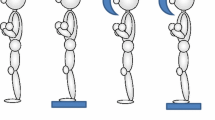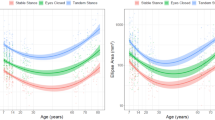Abstract
Background and aims: With research demonstrating that older adults are more likely to sustain a loss of balance than younger adults, the need for an account of age- related differences in postural control is apparent. Several measures of balance reported in the literature have assessed balance using an average or summative measure over the course of a trial, typically lasting several seconds. One limitation related to these measures is the inability to assess the time- course of postural control occurring throughout the trial. To this end, the current investigation assessed the temporal changes in balance both as a function of age and sensory environment. Methods: Postural control was assessed from 10 older adults (69.3± 4.7 years) and 10 younger adults (22.1±1.7 years) over the course of fifteen seconds in three different sensory environments. The sensory manipulations involved sway- referenced rotation of the floor and/or the visual surround. Results: Significant differences (p=0.001) in overall postural stability were observed between the two groups on all three sensory conditions. Additionally, time- course changes were observed between the two groups when the environment did not cause sensory conflict (sway-referenced floor or room only). However, when the environment created a situation of sensory conflict (sway-referenced floor and room) both groups followed the same time-course of postural changes. Conclusions: Interestingly, the time course of postural control for the older adults on the easiest condition was mimicked by the younger adults on a more challenging condition. However, when faced with sensory conflict there were no group differences in the time course of postural control. The findings suggest an age-related decline in the temporal control of posture in altered sensory environments.
Similar content being viewed by others
References
Baker SP, Harvey AH. Fall injuries in the elderly. Clin Geriatr Med 1985; 1: 501–12.
Morris JC, Rubin EH, Morris EJ, Mandel SA. Senile dementia of the Alzheimer’s type: an important risk factor for serious falls. J Gerontol 1987; 42: 412–7.
Sattin RW, Lambert Huber DA, DeVito CA, et al. The incidence of fall injury events among the elderly in a defined population. Am J Epidemiol 1990; 131: 1028–37.
Lord SR, Ward JA, Williams P, Anstey KJ. Physiological factors associated with falls in older community-dwelling women. J Am Geriatr Soc 1994; 42: 1110–7.
Means KM, O’Sullivan PS, Rodell DE. Balance, mobility, and falls among elderly African American women. Am J Phys Med Rehabil 2000; 79: 30–9.
Woollacott MH, Shumway-Cook A, Nashner LM. Aging and posture control: changes in sensory organization and muscular coordination. Int J Aging Hum Dev 1986; 23: 97–114.
Choy NL, Brauer S, Nitz J. Changes in postural stability in women aged 20 to 80 years. J Gerontol 2003; 58: 525–30.
Tinetti ME, Baker DI, McAvay G, et al. A multifactorial intervention to reduce the risk of falling among elderly people living in the community. N Engl J Med 1994; 331: 821–7.
Lord SR, Clark RD, Webster IW. Postural stability and associated physiological factors in a population of aged persons. J Gerontol 1991; 46: M69–76.
Hill K, Kerse N, Lentini F, et al. Falls: a comparison of trends in community, hospital and mortality data in older Australians. Aging Clin Exp Res 2002; 14: 18–27.
Lord SR, Ward JA. Age-associated differences in sensori-motor function and balance in community dwelling women. Age Ageing 1994; 23: 452–60.
Peterka RJ, Black FO. Age-related changes in human posture control: sensory organization tests. J Vestib Res 1990; 1: 73–85.
Allison A, Jeka JJ. Multisensory integration: Resolving ambiguities for human postural control. In Calvert GA, Spence C, Stein BE, eds. The Handbook of Multisensory Processes. Boston, MA: Massachusetts Institute of Technology, 2004: 785–97.
Teasdale N, Stelmach GE, Breunig A. Postural sway characteristics of the elderly under normal and altered visual and support surface conditions. J Gerontol 1991; 46: B238–44.
NeuroCom International I. SMART Balance Master Operator’s Manual. [Version 6]. 10-29-2001. Clackamas, OR.
Speers RA, Shepard NT, Kuo AD. EquiTest modification with shank and hip angle measurements: differences with age among normal subjects. J Vestib Res 1999; 9: 435–44.
Camicioli R, Panzer VP, Kaye J. Balance in the healthy elderly: posturography and clinical assessment. Arch Neurol 1997; 54: 976–81.
Speers RA, Kuo AD, Horak FB. Contributions of altered sensation and feedback responses to changes in coordination of postural control due to aging. Gait Posture 2002; 16: 20–30.
Duncan PW, ed. Sensory, neuromuscular, and mechanical contributions to human balance. Alexandria, VA: American Physical Therapy Association, 1990.
Baloh RW, Fife TD, Zwerling L, et al. Comparison of static and dynamic posturography in young and older normal people. J Am Geriatr Soc 1994; 42: 405–12.
Dickin DC, Rose DJ. Sensory organization abilities during upright stance in late-onset Alzheimer’s-type dementia. Exp Aging Res 2004; 30: 373–90.
Cohen H, Heaton LG, Congdon SL, Jenkins HA. Changes in sensory organization test scores with age. Age Ageing 1996; 25: 39–44.
Nashner L. Practical biomechanics and physiology of balance. In Jacobson G, Newman C, Kartush J, eds. Handbook of Balance Function and Testing. St. Louis: Mosby Year Book, 1993: 261–79.
Hageman PA, Leibowitz JM, Blanke D. Age and gender effects on postural control measures. Arch Phys Med Rehabil 1995; 76: 961–5.
Author information
Authors and Affiliations
Corresponding author
Rights and permissions
About this article
Cite this article
Dickin, D.C., Brown, L.A. & Doan, J.B. Age-dependent differences in the time course of postural control during sensory perturbations. Aging Clin Exp Res 18, 94–99 (2006). https://doi.org/10.1007/BF03327423
Received:
Accepted:
Published:
Issue Date:
DOI: https://doi.org/10.1007/BF03327423




